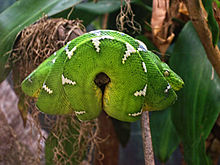Emerald tree boa
| Emerald tree boa | |
|---|---|

| |
| Scientific classification | |
| Domain: | Eukaryota |
| Kingdom: | Animalia |
| Phylum: | Chordata |
| Class: | Reptilia |
| Order: | Squamata |
| Suborder: | Serpentes |
| Family: | Boidae |
| Genus: | Corallus |
| Species: | C. caninus
|
| Binomial name | |
| Corallus caninus | |
| Synonyms | |
| |
The emerald tree boa (Corallus caninus)[3] is a boa species found in the rainforests of South America. Since 2009 the species Corallus batesii has been distinguished from the emerald tree boa.[4] Like all other boas, it is nonvenomous.
Description

Adults grow to about 6 feet (1.8 m) in length. They have highly developed front teeth that are likely proportionately larger than those of any other non-venomous snake.[5]
The color pattern typically consists of an emerald green ground color with a white irregular interrupted zigzag stripe or so-called 'lightning bolts' down the back and a yellow belly. The bright coloration and markings are very distinctive among South American snakes. Juveniles vary in color between various shades of light and dark orange or brick-red before ontogenetic coloration sets in and the animals turn emerald green (after 9–12 months of age).[6] This also occurs in green tree python (Morelia viridis), a python species in which hatchlings and juveniles may also be canary yellow or brick-red. As opposed to popular belief, yellow juveniles (as in the green tree python) do not occur in the emerald tree boa.
Some
The emerald tree boa appears very similar to the southern green tree python (Morelia viridis) from southeast Asia and Australia. This is an example of convergent evolution: the species are only very distantly related. Physical differences include the head scalation and the location of the heat pits around the mouth.

Etymology
The
Geographic range
Found in
Diet
The diet consists primarily of small mammals, but they have been known to eat some smaller bird species as well as lizards and frogs. Due to the extremely slow metabolism of this species, it feeds much less often than ground dwelling species and meals may be several months apart.
Previously, it had been thought that the primary diet consisted of birds. However, studies of the stomach contents of this species indicate that the majority of its diet consists of small mammals such as
Reproduction
The emerald tree boa is
References
- . Retrieved 12 November 2021.
- ^ ISBN 1-893777-01-4(volume).
- ISBN 0-8069-6460-X.
- ^ "Corallus caninus". Integrated Taxonomic Information System. Retrieved 3 July 2008.
- ISBN 0-448-11856-4.
- S2CID 86083502.
- ^ Walder, Rico (17 November 2014). "Expert Care for the Emerald Tree Boa". Reptiles Magazine.
- ISBN 978-1-4214-0135-5. (Corallus batesii, p. 19).
- ^ "Corallus caninus (Emerald Tree Boa)". Animal Diversity Web.
Further reading
- Mattison, Chris (1999). Snake. DK Publishing. ISBN 0-7894-4660-X.
External links
- Corallus caninus at the Reptarium.cz Reptile Database. Accessed 4 July 2008.
- Corallus.com: Emerald Tree Boa at Corallus Dot Com. Accessed 4 July 2008.
- Amazon Basins LLC. Accessed 4 July 2008.
- Corallus caninus. Accessed 8 August 2008.
- Emerald Tree Boa, Beautiful Green Pet Snake

